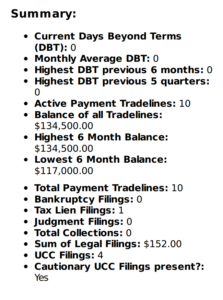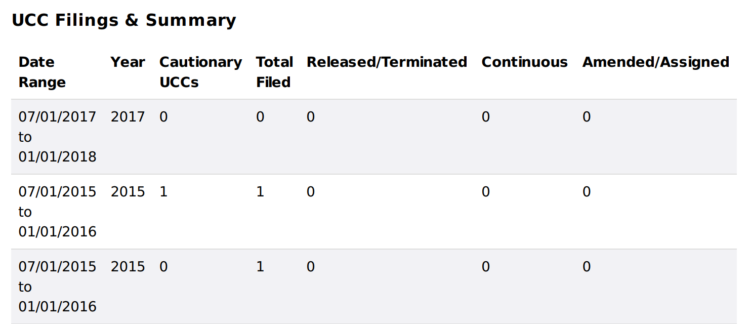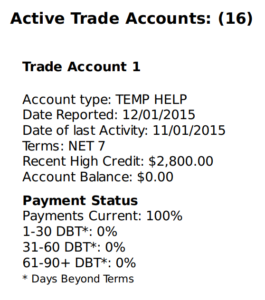Strong business credit is one of the major building blocks of successfully growing a business. A clean report with killer scores makes it easier to qualify for good rates on financing, and keeping track of what’s in your report can help you avoid becoming a victim of fraud.
But reading a business credit report isn’t easy if you’re not familiar with the industry mumbo jumbo of credit reporting agencies. Here’s your guide to demystifying the information in your report, so you can review your report with confidence.
Your Experian Business Credit Report
Below you’ll find screenshots from an Experian Intelliscore report you’d get from a Premium Nav account. You’ll see the name of the company and the date the last date the report was updated in the upper right corner. Here’s what is important to review in a business credit report:
1. The Credit Score
This report shows that the business has a 78 out of 100 which is low risk even though it’s far from a perfect score. A score above 76 is considered low risk, while a score below 25 will be higher risk.

2. Business Overview Information
This section contains basic information about the business, including its location, age, legal name and DBA (trade name), industry, number of employees, and the names of key personnel in the company. This section can also contain information about parent companies and subsidiaries, as well as sales information.
On your business credit report you’ll want to verify that all this information is correct. If it’s not, the data might be showing old information or, worse, information from another business.
Triple check your SIC and NAICS codes. You can see what the code on your report means by doing a quick search for your code here. SIC/NAICS codes are obtained through public record data such as administrative records and Census surveys, and if you’re misclassified under the wrong industry, there’s a chance that it could bring down your scores.
3. Factors Influencing Your Score
There are many factors that influence your business credit score. This is an important part of the report because it’s a guide for what part of the report the business should give attention to. This report indicates the presence of derogatory legal items—this could mean tax liens, judgments, or bankruptcies.

4. Business Credit Overview
The “summary” section of is also a good reference for where to focus your time. Here’s what some of these terms mean:
- Days Beyond Terms (DBT) tells us how late the business is on paying its bills. If the monthly average DBT is 5, that means that over the last month, the business has paid an average of 5 days late.
- A tradeline is an open account with a supplier or vendor. Often times, vendors will offer trade agreements to customers that pay on time. The more active tradelines you have, the better Experian will be able to calculate an accurate score. To calculate credit utilization, this scoring model compares the current credit utilized to the highest balance as of late.
- A UCC filing is added to your business credit file when you’re working with a creditor that claims the rights to your assets should you default. Cautionary UCCs means that you have pledged things like your accounts, contracts, inventory, or lease as collateral for a loan. This serves as a sign to creditors that your business is stressed financially.
5. Focus on The Problem Areas
The report above indicates the business has a tax lien, so that’s something the owner will want to focus on. The lien is a six-year-old state tax lien filed by the county office. According to Experian, tax liens only stay on a business credit report for six years and nine months, so the owner will want to keep an eye on that to make sure it’s removed in a timely manner (read here about how long mistakes stay on your business credit reports). If the owner believes the tax lien to be the owner, they’ll need to contact Experian and the County office reporting the lien.
Under UCC filings, there’s a number of filings listed, including cautionary UCCs. Not much information is provided, but if UCCs appear on your report you should double check the filings with the corresponding date. Make sure you worked with a lender during the date in question to make sure there are no errors on your report.

6. Your Trade Account History
The active trade accounts area of the report gives details on which suppliers/vendors the business is working with and on what terms. The tradelines listed don’t typically include the name of the lender or vendor, but it will include some details, like:
- Account type: the nature of the supplier/vendor the business is working with. This could be distributors, a contract with the bank, a utility company, etc.
- Date reported: the last date the vendor/supplier reported any payment information to business credit reporting agencies.
- Date of last activity: the last time the business made a payment to the supplier/vendor.
- Terms: Net 7 indicates that as per the business’s agreement with the vendor/supplier, this business has a payment due date seven days after the service was provided.
- Recent high credit: Your highest balance as of late with the supplier/vendor in question.
- Account balance: the current amount outstanding on the trade account.
To get access to the reports on your business with the same level of data, you can create a Nav account via the signup form below. We recommend that you review your reports at least once a year, or any time you see your score dropping and can’t identify any business behavior that may have caused it. Staying up to date on this information can save your business a lot of hassle (and money!) as you continue to grow your business.
This article was originally written on October 17, 2017 and updated on January 30, 2020.

Have at it! We'd love to hear from you and encourage a lively discussion among our users. Please help us keep our site clean and protect yourself. Refrain from posting overtly promotional content, and avoid disclosing personal information such as bank account or phone numbers.
Reviews Disclosure: The responses below are not provided or commissioned by the credit card, financing and service companies that appear on this site. Responses have not been reviewed, approved or otherwise endorsed by the credit card, financing and service companies and it is not their responsibility to ensure all posts and/or questions are answered.